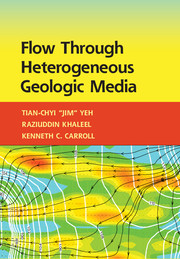Book contents
- Frontmatter
- Contents
- Preface and Acknowledgments
- 1 Fluid Statics and Dynamics
- 2 Darcy's Law for Saturated Porous Media
- 3 Darcy's Law for Unsaturated Porous Media
- 4 Stochastic Conceptualization of Heterogeneity
- 5 Governing Flow Equations for Heterogeneous Media Conceptual Models
- 6 Equivalent Homogeneous Media Conceptual Models
- 7 Flow toward a Well Due to Pumping (Part 1)
- 8 Flow toward a Well Due to Pumping (Part 2)
- 9 Stochastic Approaches
- References
- Index
8 - Flow toward a Well Due to Pumping (Part 2)
Published online by Cambridge University Press: 05 July 2015
- Frontmatter
- Contents
- Preface and Acknowledgments
- 1 Fluid Statics and Dynamics
- 2 Darcy's Law for Saturated Porous Media
- 3 Darcy's Law for Unsaturated Porous Media
- 4 Stochastic Conceptualization of Heterogeneity
- 5 Governing Flow Equations for Heterogeneous Media Conceptual Models
- 6 Equivalent Homogeneous Media Conceptual Models
- 7 Flow toward a Well Due to Pumping (Part 1)
- 8 Flow toward a Well Due to Pumping (Part 2)
- 9 Stochastic Approaches
- References
- Index
Summary
Introduction
This chapter is an extension of the analytical models of radial flow toward a well, introduced in Chapter 7, which assumes that aquifers are confined and unbounded (i.e., infinitely extended aquifers). Here we derive analytical solutions for flow toward a well considering either impermeable or recharge boundaries at some distance from the well. Afterward, we discuss analytical models for leaky confined aquifers and unconfined aquifers. At last, we discuss the necessity of using the variably saturated flow model developed in Chapter 5 for analysis of pumping tests in unconfined aquifers.
Boundary Effects in Confined Aquifers
Aquifers are generally bounded by geologic features, such as faults, bedrocks of surrounding mountains, and rivers. As a result, effects of such boundaries on the observed well hydrographs are expected during an aquifer test or prediction of groundwater flow. Therefore, a good understanding of these effects is essential for interpretation of any aquifer tests and/or forecasts of water levels and groundwater flow in aquifers.
Rapid advances in numerical modeling techniques, such as three-dimensional finite difference or finite element numerical models, are most suitable for investigating the boundary effects, because they can realistically incorporate the three-dimensional configuration of these geologic boundaries. Nevertheless, the method of images has been employed for decades to implement these boundaries in analytical models for radial flow toward a well in a plan view. It remains an important topic in subsurface hydrology. This is attributed to the fact that the logic and idea behind the method are innovative, elegant, and practical. This section, therefore, aims not only to investigate the effects of geologic boundaries, but also to introduce the method of images.
Geologic or natural boundaries generally are irregular and complex in shape and may exhibit gradual transitions. In order to incorporate such boundaries in any analytical model(s), we will need to simplify their complexity first. Specifically, we will assume that all the boundaries exhibit abrupt or sharp discontinuity, and the boundaries are straight vertical planes, cutting through the aquifer. While these assumptions may be unrealistic, they facilitate analytical solutions, which reveal useful information about general effects of boundaries on the drawdown due to pumping in an aquifer. Two hydrologic boundaries will be examined in this section, namely, 1) impermeable and 2) recharge boundaries.
- Type
- Chapter
- Information
- Flow through Heterogeneous Geologic Media , pp. 245 - 288Publisher: Cambridge University PressPrint publication year: 2015

